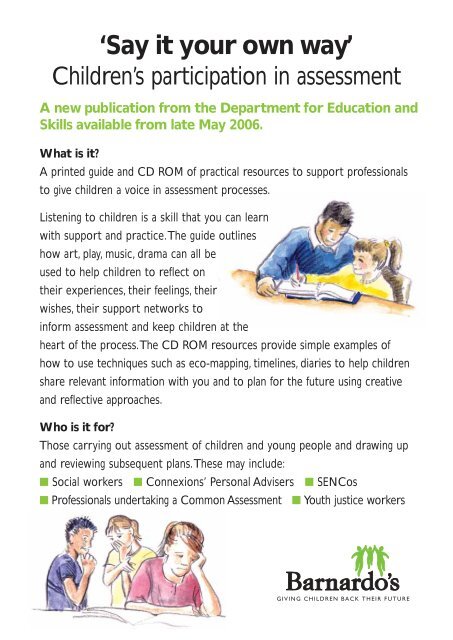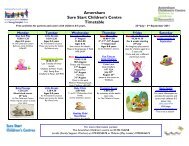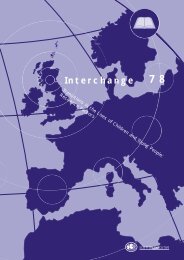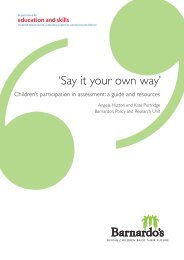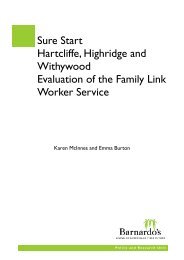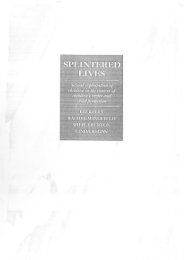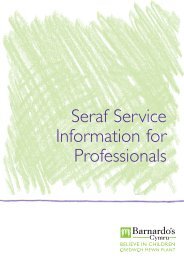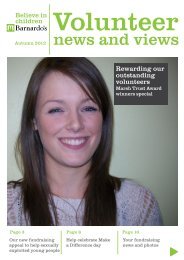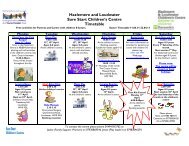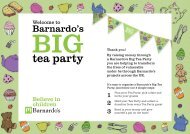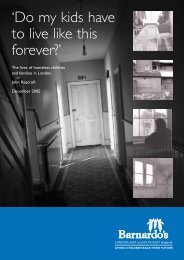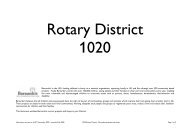'Say it your own way' - Barnardo's
'Say it your own way' - Barnardo's
'Say it your own way' - Barnardo's
You also want an ePaper? Increase the reach of your titles
YUMPU automatically turns print PDFs into web optimized ePapers that Google loves.
‘Say <strong>it</strong> <strong>your</strong> <strong>own</strong> way’<br />
Children’s participation in assessment<br />
A new publication from the Department for Education and<br />
Skills available from late May 2006.<br />
What is <strong>it</strong>?<br />
A printed guide and CD ROM of practical resources to support professionals<br />
to give children a voice in assessment processes.<br />
Listening to children is a skill that you can learn<br />
w<strong>it</strong>h support and practice.The guide outlines<br />
how art, play, music, drama can all be<br />
used to help children to reflect on<br />
their experiences, their feelings, their<br />
wishes, their support networks to<br />
inform assessment and keep children at the<br />
heart of the process.The CD ROM resources provide simple examples of<br />
how to use techniques such as eco-mapping, timelines, diaries to help children<br />
share relevant information w<strong>it</strong>h you and to plan for the future using creative<br />
and reflective approaches.<br />
Who is <strong>it</strong> for?<br />
Those carrying out assessment of children and young people and drawing up<br />
and reviewing subsequent plans.These may include:<br />
■ Social workers ■ Connexions’ Personal Advisers ■ SENCos<br />
■ Professionals undertaking a Common Assessment ■ Youth justice workers
The guide and CD ROM resources…<br />
support assessment under<br />
■ The Framework for the Assessment of Children in<br />
Need and their Families (Assessment Framework) and<br />
the Integrated Children’s System (ICS).<br />
■ The Connexions’ Assessment, Planning,<br />
Implementation and Review (APIR) Framework.<br />
■ The Common Assessment Framework (CAF).<br />
and the planning and review of…<br />
■ The Individual Education Plan (IEP) that follows<br />
assessment of need under the Special Educational<br />
Needs Code of Practice 2002;<br />
■ The Individual Reintegration Plan for a child excluded from school;<br />
■ The Personal Education Plan (PEP) for a looked after child;<br />
■ Trans<strong>it</strong>ion planning under the Special Education Needs Code of Practice 2002;<br />
■ Pathway Planning and review for care leavers;<br />
■ Planning under the Connexions’ Assessment, Planning, Implementation and Review<br />
(APIR) framework.<br />
The guide sets out a number of principles and reasons for involving<br />
children in assessment:<br />
■ Direct work w<strong>it</strong>h children must be at the heart of every assessment<br />
■ You should listen to a child before you try to make changes in their life, at the<br />
same time ensuring their safety<br />
■ Children have knowledge and understanding that will help you to help them<br />
■ Direct work w<strong>it</strong>h children should use child-centred methods of communication<br />
■ Creative and activ<strong>it</strong>y-based ways of communicating can help adults to listen to<br />
children and children to communicate w<strong>it</strong>h adults<br />
The guide and CD ROM of resources is available<br />
(Price £12) from the Barnardo’s webs<strong>it</strong>e<br />
www.barnardos.org.uk/say<strong>it</strong><strong>your</strong><strong>own</strong>way


